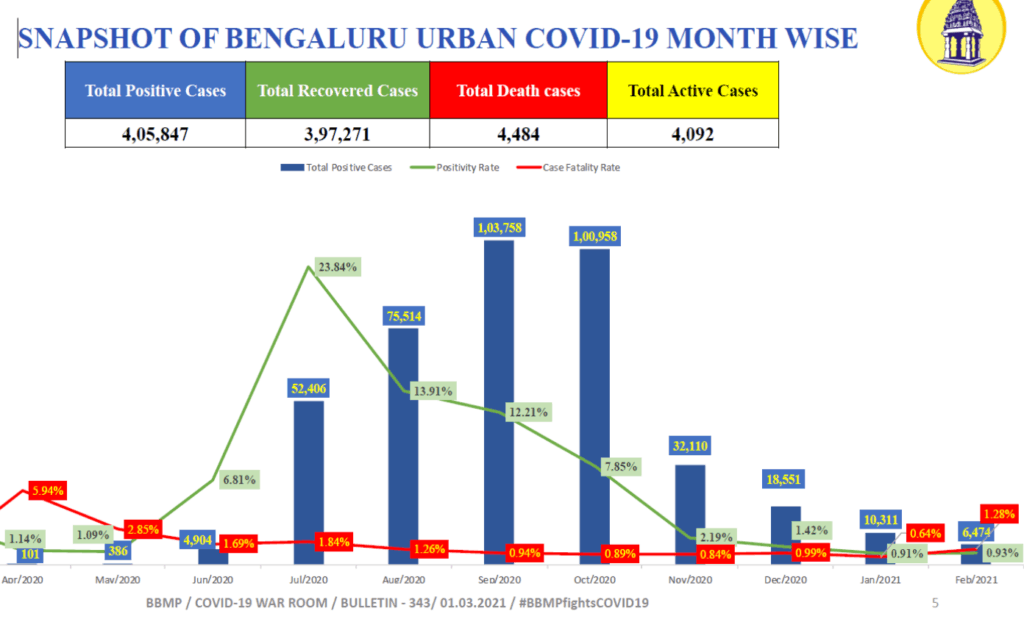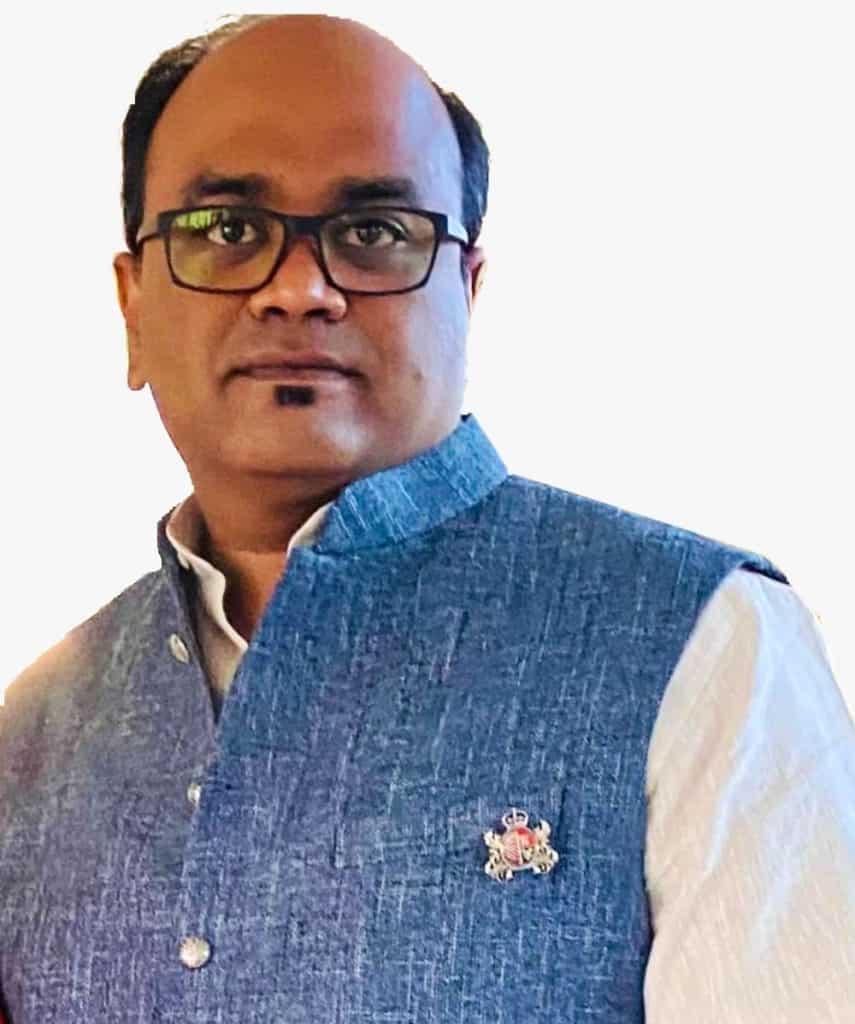In mid-February, the Bruhat Bengaluru Mahanagara Palike went into a tizzy as COVID clusters were identified in different parts of the city. Emergency meetings were held, new guidelines issued, entry of travellers from two neighbouring states restricted.
Does this mean the city will soon see a second wave?
After a major peak in cases last year, COVID positivity rate and case fatality rate had been steadily declining in Bengaluru. While positivity rate indicates the percentage of positive cases among those tested, case fatality rate (CFR) is the percentage of deaths among those who tested positive.
The following graph, from the BBMP COVID war room bulletin on March 1, shows that positivity rate and CFR reached their peak in July (23.84% and 1.84% respectively). In terms of absolute case numbers, Bengaluru hit the maximum cases in September (1,03,758 cases). Up till this January, these numbers have kept declining.

But as per the war room bulletin of March 1, the test positivity rate in February is marginally higher than that in January (0.93% vs 0.91%), and has not followed the downward trend of the past few months. The CFR of February is in fact much higher than previous months, at 1.28%. In fact, it was only in last August that Bengaluru had CFR this high.
While the city has been free of major COVID clusters for a while, in mid-February, BBMP identified two clusters – Manjushree College of Nursing in Kaval Byrasandra where 40 students tested positive, and SNN Raj Lakeview apartment in Bilekahalli where 103 residents turned positive after an event in their clubhouse. In the Bilekahalli apartment, 96 out of the 103 infected people were aged above 60 years. Over the next few days, 27 residents of SJR Watermark apartment at Ambalipura tested positive as well.
Most recently, towards the end of February, four clusters were identified in Yelahanka – Agraghami College, Purva Venezia apartment, Sambhram Academy of Management Studies, and the Inspire Livesuit PG run by the Academy. As of February 26, a total of 33 cases had been reported from these clusters.
“May not be second wave, but cases rising as people gather”
With the reporting of the clusters, the BBMP Commissioner has held meetings with Palike officials and released circulars. The minutes of the meetings as well as the circulars mention that a second wave is anticipated.
However Dr Giridhar Babu, epidemiologist and a member of Karnataka government’s COVID Technical Advisory Committee (TAC), says there is no data to indicate a second wave as of now. “The recent clusters are from super-spreader events in closed gatherings. That is, only 1-2 people out 100 in the gathering would have COVID, and they would infect everyone else. So it’s not that large numbers in the general population are getting infected; rather, super-spreader events are happening due to gatherings – as it’s the marriage season now, places like cinema halls are opening to full capacity, etc.”
Dr Giridhar says that the majority of those infected from these super-spreader events have been asymptomatic. “For example, of over 100 people in a cluster, 95 were asymptomatic. We come to know of these clusters because BBMP’s testing and surveillance measures are good. As soon as cases are identified, BBMP is testing more people and enforcing containment measures.”
Regarding the high fatality rate in February, Dr Giridhar says it could be due to the nature of cases that month. According to the BBMP bulletin, 83 people have died, out of the 6,474 positive cases identified in February. Whereas in January, the death rate was much lower – 66 deaths out of 10,311 positive cases.

“Doctors in the city whom I spoke to, say there has been no increase in number of very serious cases or ICU admissions. So the increased fatality rate could be due to the nature of certain cases this month,” Dr Giridhar says.
But he does not rule out the possibility of a second wave in Bengaluru that’s as big or worse than the first wave. “If this does happen, it could be due to the spread of a new virus strain, large influx of unvaccinated people from other places, etc. This is because people in Bengaluru have achieved close to herd immunity, so a sudden spurt in cases is not likely to happen otherwise. At this point, there is no evidence of a second wave or new strains.”
The TAC that Dr Giridhar is part of, had recommended several measures to BBMP in view of the rising cases, such as increasing the number of COVID tests. But he says test numbers are still insufficient. For example, the war room bulletin of February 14 mentioned that 24,248 tests had been done in the previous 24 hours. Whereas the bulletin of March 1 showed that the test numbers had increased only to 30,451.
But eventually, participation of the public is more important in ensuring COVID norms, Dr Giridhar says. “Everyone wants BBMP Marshals to enforce COVID norms in their locality, this is not possible.”
“Citizens, authorities should go back to taking precautions”
Dr Abdul Ghafur, Consultant in Infectious Diseases at Apollo Hospital, Chennai, and advisory member for the National Antibiotic Policy, says the public and authorities have to go back to the basics.
“Mutations of the virus and the rise of new variants – within India or outside – is inevitable. To know more about the new strains, extensive molecular analysis is needed. UK was rigorous in their molecular analysis, hence they identified a new, strong strain,” he says “But the identification of variants is important only from an epidemiological point of view. For the ordinary person, whichever variant it is, they have to take the same precautions like masking and social distancing.”
Read More: Battle-weary Covid warriors dreading second wave
Authorities need to go back to the basics too, Dr Abdul says. “A lockdown should not be done unless it is inevitable. But authorities need to do more surveillance – more testing, more syndromic surveillance (screening of all hospital admissions), putting more restrictions on gatherings, etc.”
Dr Abdul believes that a second wave – which may be smaller than the first wave – is inevitable in metro cities. “These cities have achieved substantial immunity, but not herd immunity yet. A second wave is inevitable as people lower their guard and don’t follow COVID norms.” He says the second wave need not be caused by a new strain of virus. “COVID has not gone anywhere. The predominant old strain is still circulating within the population.”
“Speed up vaccination”
Both Dr Giridhar and Dr Abdul say that speeding up vaccination is critical at this point, especially that of the elderly and those with comorbidities.
Dr Abdul says, “Even if a new strain is circulating, the majority of cases now will be of the old strain. So vaccination will be effective in bringing down case numbers. Even in the case of new, strong variants, it’s not that the vaccine will be ineffective, just that the percentage of efficacy will reduce. So authorities need to do vaccinations quicker, especially in states that have more cases.”

While private hospitals are now allowed to administer COVID vaccines, Dr Abdul says government should also ensure that people should not be able to pay more and jump the queue in private hospitals. “Those above 60 and those above 45 with comorbidities themselves should get the vaccine first,” he says.
How BBMP has responded to increasing cases
On February 16, BBMP Commissioner Manjunath Prasad called a meeting of officials and Resident Welfare Associations, asking them to ensure that citizens followed COVID protocols, especially in social gatherings, in gyms and swimming pools. The idea of re-activating the Home Quarantine Squad for stricter monitoring, was considered.
The same day, BBMP issued a circular that mandated COVID-negative certificates for those arriving to the city from Kerala. (The requirement was later extended to travellers from Maharashtra also). The circular said that a cluster of five or more cases would be notified as a containment zone and put under special surveillance, COVID-positive samples would be sent to NIMHANS for genome sequencing, and prescribed specific measures for hostels.
In a meeting on February 19, Manjunath Prasad said enhanced testing was needed, along with more marshals and police personnel to ensure masking in public areas. While BBMP had previously decided to use electoral rolls to create list of vaccine beneficiaries, Manjunath said at this meeting that BBMP lacked accurate data on comorbidities in individuals. He instructed officials to ensure door-to-door health screening of residents in all slums in the city, and to create a population registry that would help identify vaccine beneficiaries.
A BBMP circular on February 19 said food handlers and catering services in containment zones should remain closed. Catering services were also asked to ensure fortnightly RT-PCR testing for their staff, and to follow precautions like restricting the number of people using elevators, norms for AC and ventilation, etc.
On February 20, Karnataka government issued revised guidelines for international travellers to the state, based on the Centre’s guidelines as well as recommendations of TAC.
On February 21, Manjunath Prasad held a meeting in view of surging cases in Maharashtra and Kerala. He instructed BBMP officers to strengthen surveillance using community and RWA members, identify events that can potentially lead to outbreaks, make visits to closed gatherings, etc. Primary Health Centres (PHCs) had to report daily cases in the community, and to submit zero-reports when no cases were present. Hospitals had to do syndromic surveillance and give daily reports of all deaths.
Also Read:
“Regarding the high fatality rate in February, Dr Giridhar says it could be due to the nature of cases that month. According to the BBMP bulletin, 83 people have died, out of the 6,474 positive cases identified in February. Whereas in January, the death rate was much lower – 66 deaths out of 10,311 positive cases.”
What I have noticed is that a lot of deaths are getting reconciled this month.
So in the second half of Feb we were seeing deaths being reported from Dec 2020. I do not know how this can happen. Even in Feb, a lot of deaths were being reported from Jan. When I say reported from Jan or Dec, I mean the date of death was in that month.
We should do some reconciling to understand how many deaths really happened in Jan or Feb or Dec 2020. That data is pretty wonky.
Taking all precautions and increasing the speed and reach of vaccination (vaccinate anyone on payment of a fixed reasonable amount) are critical at this juncture.
Why school and college are open we should not take risk for students there life is more important
When 2 cases in banglore total lockdown but when 400 to 500 cases in Karnataka state and 200 to 300 cases alone in banglore everything is opened mainly the malls and the educational institutions with no measures taken in the educational institutions.
I do agree with Vacation speed, how many dosage does we have in pipeline, how much will metro cities such as Bangalore will receive. Will it be sufficient for above 45/60 age group. Also one person needs two dosage. We need a website to show all these data to give clear picture to everyone on awareness and to know if we are on right track.
In Bangalore college,school and institute should be closed because we are students we travel to our college,school and institute by cab and we don’t know whether they are sanitizing the cab or not so it’s better to do online classes it’s nothing worng in online classes just make it strict and I can see in Bangalore some people are not wearing mask,spitting all around and not maintaining social distancing..
Many IT companies are also planning to open from May.. this will again increase cases in B’lore.